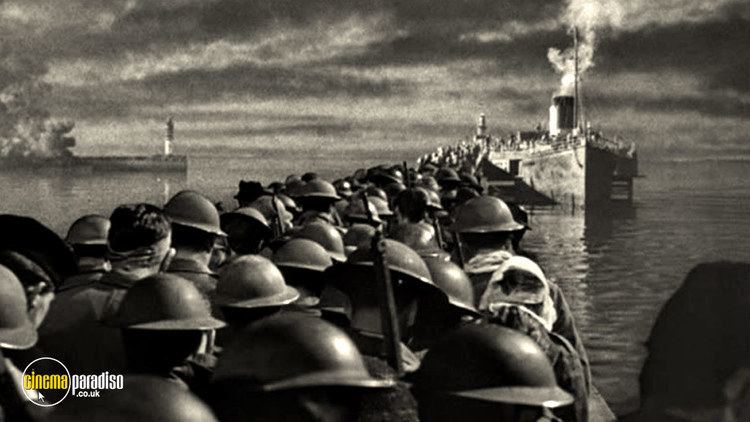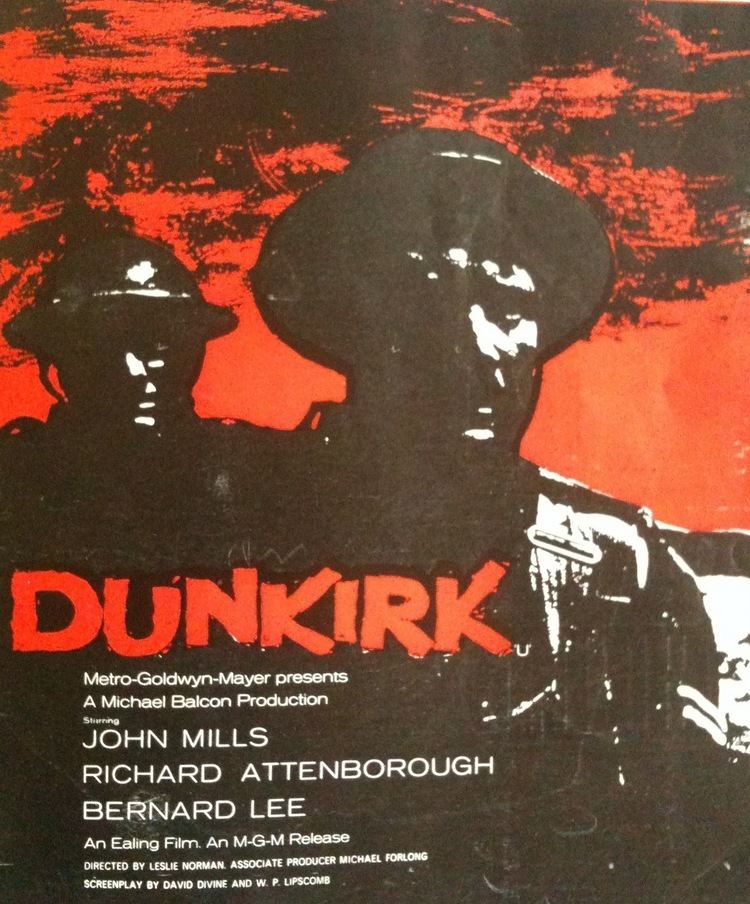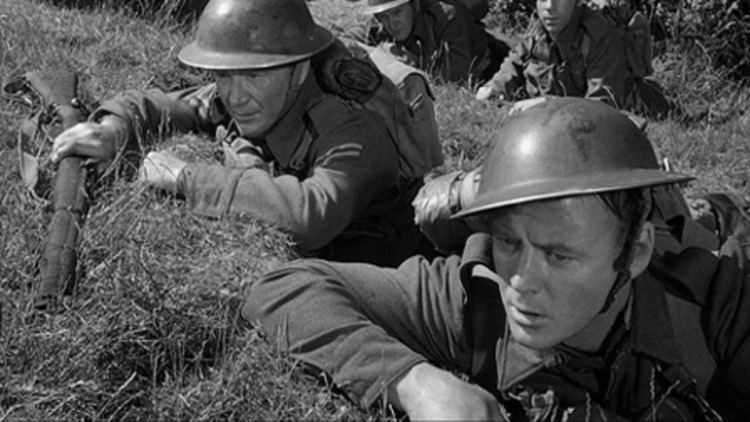7 /10 1 Votes7
Initial release 20 March 1958 | 7.1/10 IMDb Produced by Michael Balcon | |||||||||||||||||||||||||||||||||
 | ||||||||||||||||||||||||||||||||||
Written by J.S. Bradford (book)Ewan Butler (book)David Divine (screenplay) Starring John MillsRichard AttenboroughBernard Lee Cast Similar Corporal movies, John Mills movies, War movies | ||||||||||||||||||||||||||||||||||
Dunkirk 1958
Dunkirk is a 1958 British war film directed by Leslie Norman and starring John Mills, Richard Attenborough and Bernard Lee. It was based on two novels: Elleston Trevor's The Big Pick-Up and Lt. Col. Ewan Hunter and Maj. J. S. Bradford's Dunkirk.
Contents

Dunkirk
Plot

The film relates the story of Operation Dynamo, the evacuation of surrounded British and French troops from the beaches of Dunkirk in May and June 1940 during the Second World War. It does so principally from the viewpoints of two people: a newspaper reporter and a soldier.
A pessimistic journalist named Charles Foreman (Bernard Lee) tries unsuccessfully to rouse his complacent readers on the home front from the notion of a Phoney War before it is too late. His friend John Holden (Richard Attenborough) owns a small factory manufacturing buckles and is quite pleased with his profits from war work. Meanwhile, the Germans rapidly take the initiative in the Battle of France threatening to destroy the Allied forces bottled up around Dunkirk.

Corporal "Tubby" Binns (John Mills), his platoon leader Lieutenant Lumpkin and Tubby's deleted section return to their camp after blowing up a bridge, only to discover that their company has left during the night, leaving them alone in France. One man and a truck have been left to wait for them, but the driver and Lumpkin are killed in a bomber attack, leaving Tubby in charge of a five-man squad with no idea what the situation is. It is up to Tubby to keep his increasingly demoralised men on the move. Unsure of where to go, they dodge the advancing Germans and reach a Royal Artillery battery camp. They receive some food, before losing one of their men (Pte. Frazer) and being ordered to go to Dunkirk with two other stragglers, where the rest of the British Expeditionary Force (BEF) and tens of thousands of French soldiers are gathering, hoping to be evacuated. After spending the night in a farmhouse, a German patrol arrives where Pte. Dave Bellman is shot badly in the chest, forcing Tubby to leave him behind as it is Dave's only chance. Eventually, they get a lift in an RAF lorry and reach the beaches.

The Admiralty commandeers all available civilian boats to help evacuate the troops from the beaches. Foreman insists on taking his motorboat Vanity himself, despite warnings of the danger. Others follow his example. An acquaintance, Holden (Richard Attenborough), a motor engineer and businessman, self-satisfied with the profits he has made from the Phoney War, does the same with some reluctance. However, as time goes by, his lack of commitment melts away.
The soldiers on the beaches are subjected to regular aerial bombing and strafing. Tubby and his men get aboard a ship, only to have it blown up and sunk before it can depart. When they get back to the beach and wait for more boats to arrive, Pte. Barlow is hit in the face and taken to the aid station.
After ferrying soldiers to the larger vessels, Foreman's boat is destroyed by a bomber. He survives and is picked up by Holden in the Heron. When Heron's engine malfunctions, one of Tubby's men (Pte. Mike Russell) effects repairs, while Foreman and teenage crewman Frankie go ashore to survey the scene. Foreman and Tubby discuss who is responsible for the debacle. During a Sunday morning church parade, Foreman is fatally wounded in an attack by German aeroplanes. However, Holden, Tubby and the rest of his men arrive safely back in Britain.
Production
The film's beach sequences were shot at Camber Sands in south east England. The scene where the bridge was blown during the early part of the film was on the River Medway at Teston Bridge, Teston in Kent.
The wartime Dunkirk town centre was recreated using part of Rye Harbour in Sussex, England. A canal-type bridge was temporarily constructed over the upper harbour, leading on to the quayside. It was over this bridge that the refugees and troops poured into the 'town centre'. Several scenes take place at this location, particularly a tracking shot following two British Army officers as they discuss the situation. In the background, the viewer can make out Rye Church, and also some old warehouses which still exist, albeit in much restored condition. One of the warehouses was used as the interior for the 'Barn Scene'.
Director Leslie Norman later recalled:
Dunkirk was bloody difficult to make from a logistics point of view. Yet it was made for ₤400,000 and came in under budget... I was the council school boy who became a major in the war, and that had a lot to do with the way I felt about Dunkirk. I didn't think that Dunkirk was a defeat; I always thought it was a very gallant effort but not a victory.
Reception
The film's world premiere was at the Empire, Leicester Square, in London on 20 March 1958.
The film was the second most popular production at the British box office in 1958. According to MGM records it earned only $310,000 in the US and Canada but $1,750,000 elsewhere, resulting in a profit of $371,000.
An image of Sean Barrett as Frankie was used on the cover of the Smiths' 1985 single "How Soon Is Now?".
